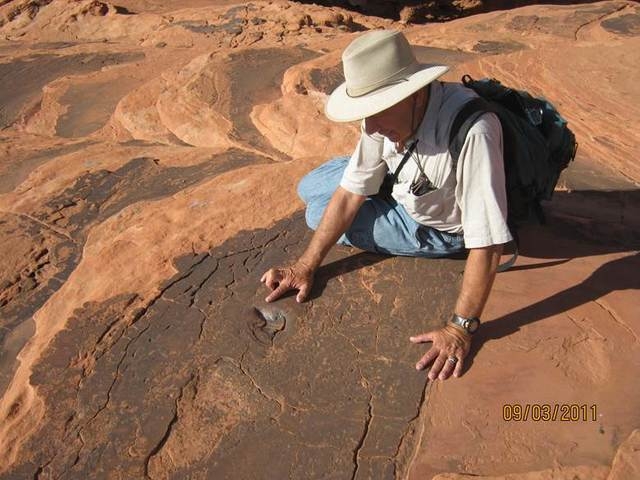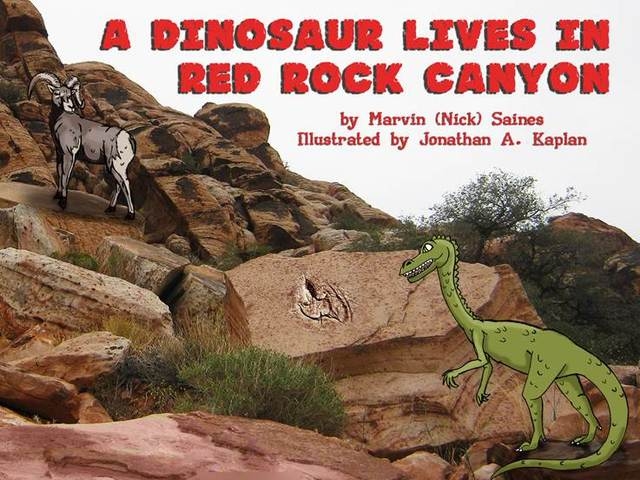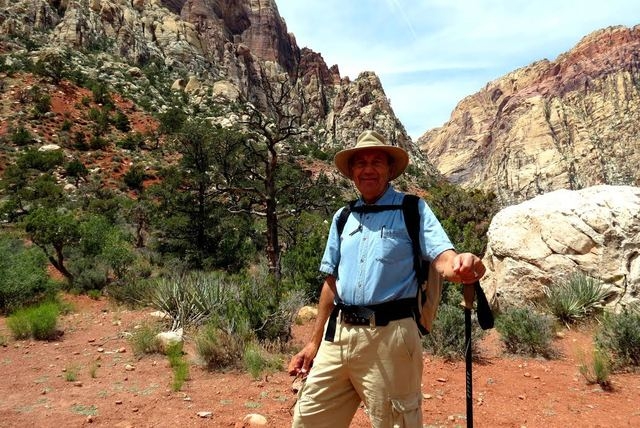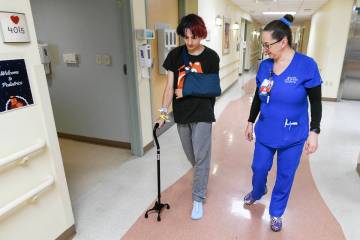Drawn to dinosaurs: Discovery inspires geologist to pen children’s book
Dr. Marvin (Nick) Saines likes old things — really old things. Specfically, his fascination is fueled by the world before mankind.
Saines is a geologist and former naturalist for the Red Rock Canyon Interpretive Association, the nonprofit that assists the Bureau of Land Management in operating the Red Rock Canyon National Conservation Area. In August 2011, he discovered a dinosaur footprint there from the Jurassic period.
Now, he has written and published a children’s book, “A Dinosaur Lives in Red Rock Canyon,” about a dinosaur that comes to life. The book is illustrated by Las Vegas artist Jonathan A. Kaplan and utilizes photos of Red Rock Canyon with a curious cartoon dinosaur, the type that likely made the track Saines discovered.
Saines is a grandfather, so he began thinking of turning his find into an educational product aimed at young children. The dinosaur talks to the other animals he comes across in the desert as he endeavors to find his own kind. The book may use a cartoon-like character and be aimed at children, but there is also an element of classroom information.
“I didn’t water down the language,” he said. “I kept it at a high level as far as (vocabulary). It’s not talking down to them.”
Saines got his own education when writing the book. Established publishers showed no interest, and he ended up self-publishing it using blurb.com. The book is 34 pages and took two years to complete.
Tom Lisby has known Saines for nearly three years and was one of the people to whom Saines showed the dinosaur track.
“It’s hard to conceptualize how long ago that was,” Lisby said. “ … That track was made in wet sand, and you can actually see the ripples that footprint made, sort of like walking on the beach. It’s kind of a moment frozen in time.”
The discovery of the track wouldn’t have happened if Saines hadn’t been leading a training session for the BLM at Red Rock Canyon in late summer 2011. He remarked to the class that “it’s only a matter of time before we find dinosaur tracks at Red Rock Canyon.”
Two of the men taking the training, Gary Smith and Lynn Nicholson, raised their hands and said, “We already did.”
Saines had them take him out to see the prints two weeks later. They were in a remote part of the conservation area. On the way there, he saw some interesting rocks, stopped to check them out and made his own discovery, a single track of a much larger animal. Without bones to further tell its story, the track is considered to be from a Jurassic-era theropod (meat-eating dinosaur), perhaps a coelophysis or megapnosaurus, he said. Near the dinosaur track Saines found are small animal tracks, probably made by a Jurassic-era scorpion or tarantula-like spider.
After the find, the group continued to the smaller tracks that Smith, Nicholson and Jeff Mishlove had found, about 700 feet farther along. Saines was photographing them when his friends told him to be careful.
“I was so excited; I was backing up, taking the pictures, and forgot I was on the edge of a cliff,” Saines said. “I almost died out there.”
It wasn’t just a fall that almost did him in. The heat was broiling and resulted in near heat-stroke symptoms such as wooziness that had them helping one another back to their vehicles. Nicholson broke his ankle, and rescuers were called.
“The dinosaurs don’t give up their secrets so easily,” Saines said.
Another trip was made to take UNLV professor and paleontologist Dr. Stephen Rowland to see the prints so he could confirm the find.
Saines now leads hikes offered through the Sierra Club. He said he is always on the lookout for more tracks or indications of what dwelled in Red Rock Canyon ages ago. Saines said that so far, footprints have been found at four different places at Red Rock but that no dinosaur bones have yet been found. The vertebra found in 2013 by Harold Larson in Triassic-period rocks in Spring Mountain Ranch is from a metoposaurus, a crocodile-like predator that lived in freshwater lakes, while the dinosaurs roamed the land.
“When we see fossil footprints, it’s not just cold stone,” said Saines. “These are traces of an animal that lived 180, 190 million years ago, and by bringing the dinosaur alive through the story, it might make one appreciate that these animals actually lived here. I always say that this is the real Jurassic Park.”
“A Dinosaur Lives in Red Rock Canyon” should get plenty of exposure at the Red Rock Canyon Visitor Center, 1000 Scenic Loop Drive, where copies are sold. Red Rock Canyon draws more than 1 million visitors a year, making it the busiest national conservation area in the country.
The BLM asks that anyone who finds what they believe to be dinosaur tracks or other fossils on public land to call 702-515-5000 and provide the specific location and photographs of the site. It is illegal to dig up or collect fossils on public land without a permit.
Saines said he is thinking about “a sequel in which the dinosaurs scare the hell out of would-be graffiti idiots and vandals.” He is also working on a book titled “Geological Treasures of Red Rock Canyon.”
“A Dinosaur Lives in Red Rock Canyon” also is available at the Springs Preserve and on amazon.com. For more information, email turtleheadbooks@aol.com.
To reach Summerlin Area View reporter Jan Hogan, email jhogan@viewnews.com or call 702-387-2949.
‘A Dinosaur Lives in Red Rock Canyon’
The book is available at the Red Rock Canyon Visitor Center, 1000 Scenic Loop Drive; at the Springs Preserve, 333 S. Valley View Blvd., and on amazon.com.
For more information, email turtleheadbooks@aol.com.





















